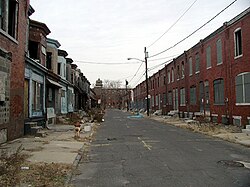

In the United States, poverty has both social and political implications. Based on poverty measures used by the Census Bureau (which exclude non-cash factors such as food stamps or medical care or public housing), America had 37 million people defined as living in poverty in 2023; this is 11 percent of the population. [1] Some of the many causes include income, inequality,[ needs update ] [2] inflation, unemployment, debt traps and poor education.[ needs update ] [3] The majority of adults living in poverty are employed and have at least a high school education. [4] Although the US is a relatively wealthy country by international standards, [5] it has a persistently high poverty rate compared to other developed countries due in part to a less generous welfare system. [4]
Contents
- History
- Progressive era 1890s-1920s
- Great Depression
- War on poverty
- 21st century
- Measuring poverty
- Poverty income thresholds
- Supplemental Poverty Measure
- Criticism
- Geography
- Poverty in U.S. territories
- Poverty in U.S. states
- Poverty and demographics using Census OPM
- Poverty and family status
- Poverty and race/ethnicity
- Poverty among Native Americans
- Poverty among African Americans
- Poverty and LGBTQ+ status
- Poverty and age
- Poverty and incarceration
- Poverty and disability
- Effects of poverty
- Education
- Health disparities
- Factors in poverty
- Fighting poverty
- See also
- Other
- International
- Notes
- References
- Bibliography and further reading
- External links
Efforts to alleviate poverty include New Deal-era legislation during the Great Depression, to the national war on poverty in the 1960s and poverty alleviation efforts during the 2008 Great Recession. The federal government has two departments which measure poverty. Under the Department of Commerce, the Census Bureau has been reporting the Official Poverty Measure (OPM) since the 1960s, while the Department of Health and Human Services defines income levels for which people are eligible for governmental anti-poverty assistance. The OPM includes cash assistance from programs like Supplemental Security Income and Temporary Assistance to Needy Families (welfare) as part of someone's income when reporting on how many people are in poverty. Since 2011 the Census Bureau has also been reporting a newer Supplemental Poverty Measure (SPM), which includes non-cash anti-poverty government assistance like Supplemental Nutrition Assistance Program (food stamps) and Medicaid (health care for the poor), and also accounts for regional differences in the cost of living. [6] [7] The SPM is considered a more comprehensive estimate of poverty. [8]
For 2021, the percentage of Americans in poverty per the SPM was 7.8%, and per the OPM was 11.6%. [9] [10] By the OPM, the poverty threshold for 2021 for a single person was $13,800, and for a family of four was $27,700. [9] In 2020, the World Bank reported that 0.25% of Americans lived below the international definition of extreme poverty, which is living on less than $2.15 per day in 2017 Purchasing Power Parity dollars. [11] [12] The SPM increased by 4.6% in 2022 to 12.4%, due to the ending of pandemic stimulus payments and tax credits, [13] [14] with around 15.3 million Americans falling into poverty over this time period according to the Center on Budget and Policy Priorities. [14]
The 2020 assessment by the U.S. Census Bureau showed the percentage of Americans living in poverty for 2019 (before the COVID-19 pandemic) had fallen to some of the lowest levels ever recorded due to the record-long period of economic growth. [15] However, between May and October 2020, some eight million people were put into poverty due to the economic effects of the COVID-19 pandemic and the ending of funds from the CARES Act. [16]

















